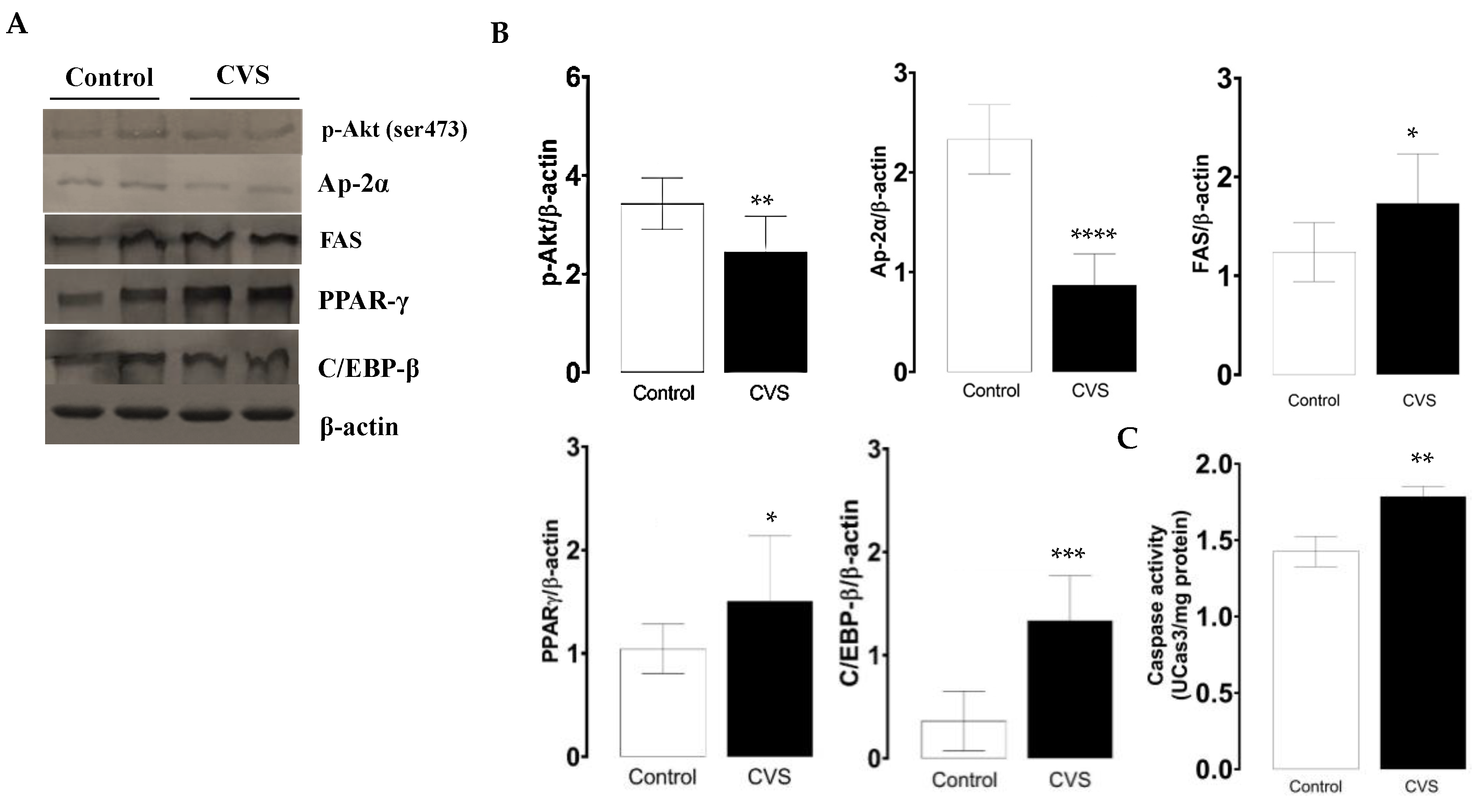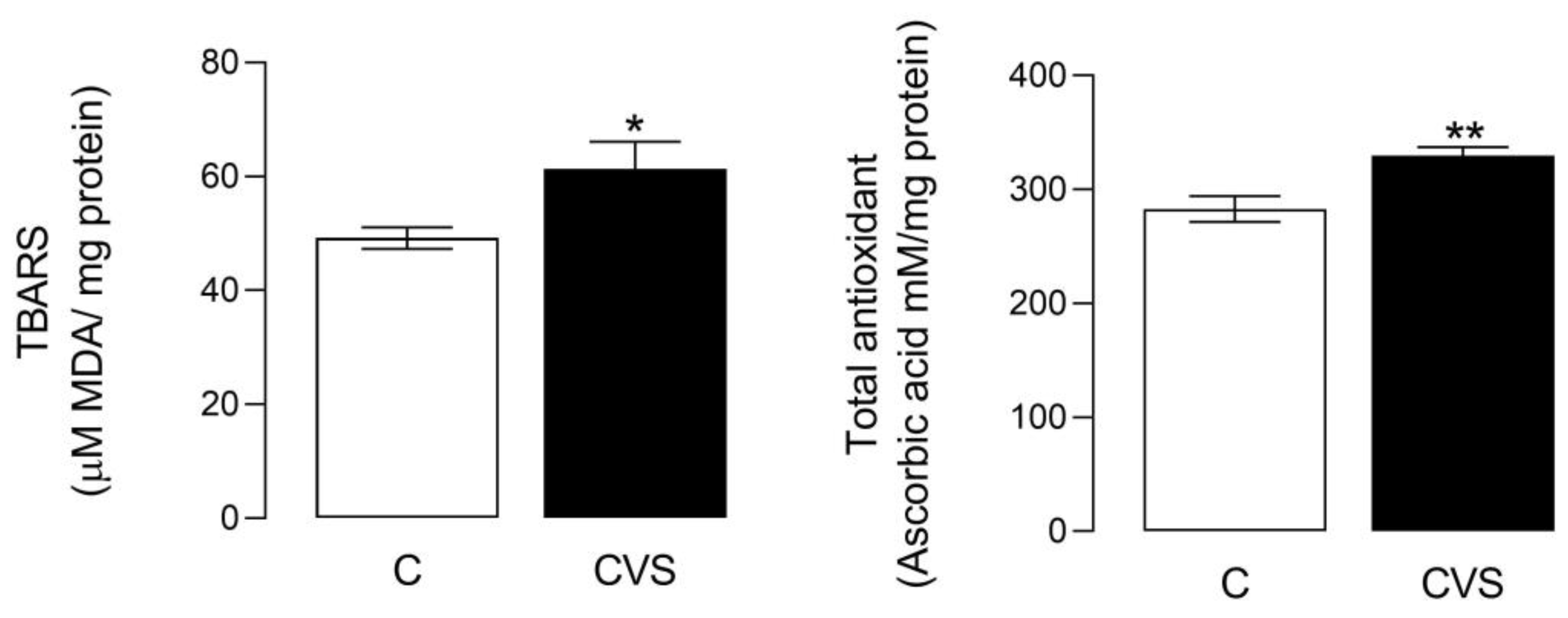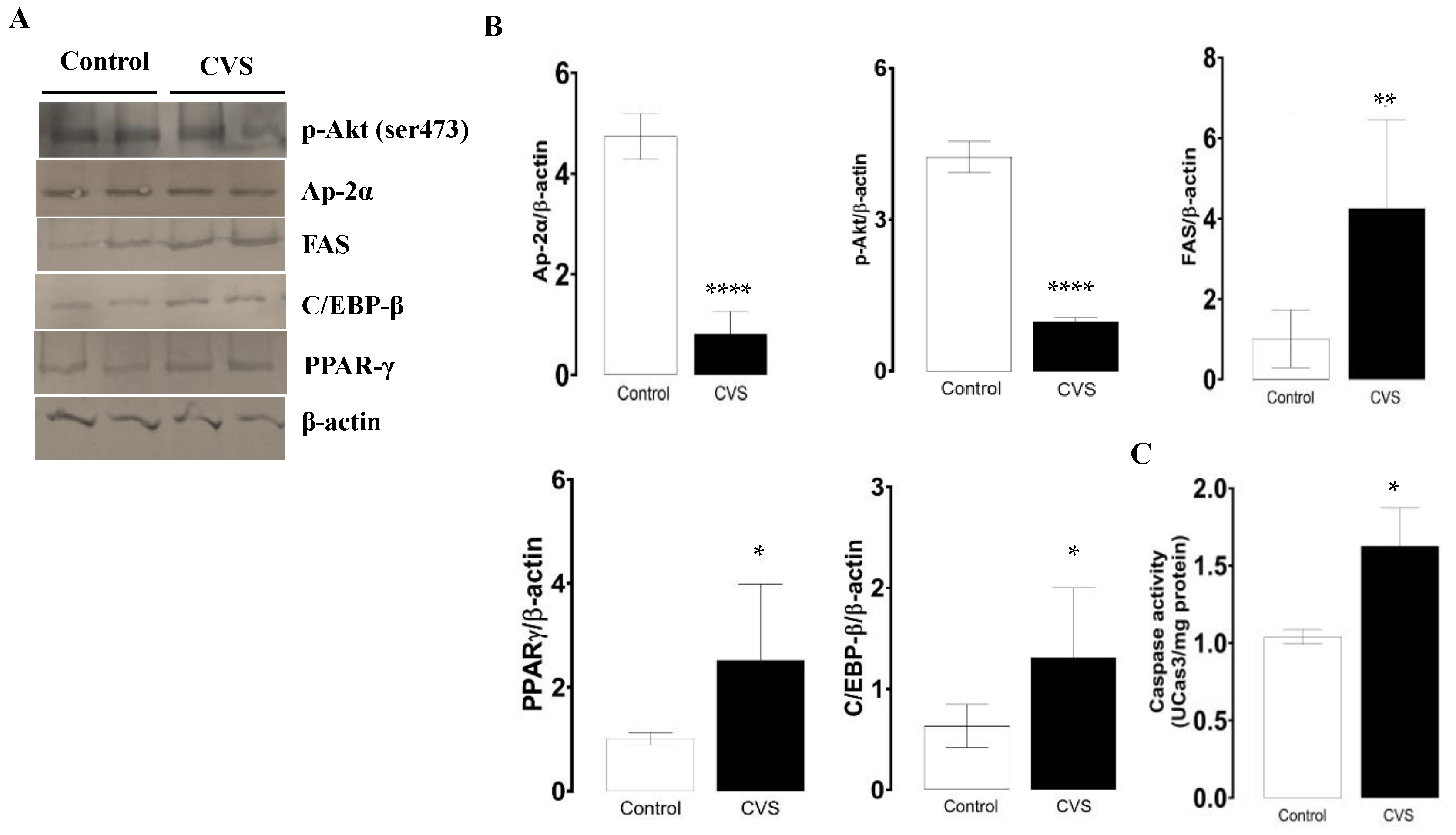Chronic Variable Stress May Induce Apoptosis in the Testis and Epididymal Sperm of Young Male Rats
Simple Summary
Abstract
1. Introduction
2. Materials and Methods
2.1. Experimental Design
2.2. Chronic Variable Stress Procedure Model
2.3. Epididymal and Complete Testicles Extract
2.4. Oxidative Stress and Total Antioxidant Status
2.5. Determination of mRNA by Quantitative RT-PCR
2.6. Western Immunoblotting
2.7. Caspase-3 Assay
2.8. Statistical Analysis
3. Results
3.1. Oxidative Stress, Antioxidant Status, and Apoptotic Marker’s Expression in the Complete Testicle from Rats Exposed to CVS
3.2. Oxidative Stress, Antioxidant Status, and Apoptosis Markers Expression in the Epididymal Sperm Extract from Rats Exposed to CVS
3.3. Effect of CVS on the Expression of Apoptosis Markers in Epididymal Sperm Extract
4. Discussion
5. Conclusions
Supplementary Materials
Author Contributions
Funding
Institutional Review Board Statement
Informed Consent Statement
Data Availability Statement
Acknowledgments
Conflicts of Interest
References
- Chu, B.; Marwaha, K.; Sanvictores, T.; Awosika, A.O.; Ayers, D. Physiology, Stress Reaction; StatPearls: Treasure Island, FL, USA, 2025. [Google Scholar]
- Koolhaas, J.M.; Bartolomucci, A.; Buwalda, B.; de Boer, S.F.; Flugge, G.; Korte, S.M.; Meerlo, P.; Murison, R.; Olivier, B.; Palanza, P.; et al. Stress revisited: A critical evaluation of the stress concept. Neurosci. Biobehav. Rev. 2011, 35, 1291–1301. [Google Scholar] [CrossRef] [PubMed]
- Pacak, K.; Palkovits, M.; Yadid, G.; Kvetnansky, R.; Kopin, I.J.; Goldstein, D.S. Heterogeneous neurochemical responses to different stressors: A test of Selye’s doctrine of nonspecificity. Am. J. Physiol. 1998, 275, R1247–R1255. [Google Scholar] [CrossRef]
- Nordkap, L.; Jensen, T.K.; Hansen, Å.M.; Lassen, T.H.; Bang, A.K.; Joensen, U.N.; Jensen, M.B.; Skakkebæk, N.E.; Jørgensen, N. Psychological stress and testicular function: A cross-sectional study of 1,215 Danish men. Fertil. Steril. 2016, 105, 174–187.e2. [Google Scholar] [CrossRef]
- Zou, P.; Wang, X.; Yang, W.; Liu, C.; Chen, Q.; Yang, H.; Zhou, N.; Zeng, Y.; Chen, H.; Zhang, G.; et al. Mechanisms of Stress-Induced Spermatogenesis Impairment in Male Rats Following Unpredictable Chronic Mild Stress (uCMS). Int. J. Mol. Sci. 2019, 20, 4470. [Google Scholar] [CrossRef]
- Nirupama, M.; Devaki, M.; Nirupama, R.; Yajurvedi, H.N. Chronic intermittent stress-induced alterations in the spermatogenesis and antioxidant status of the testis are irreversible in albino rat. J. Physiol. Biochem. 2013, 69, 59–68. [Google Scholar] [CrossRef]
- Hussain, T.; Kandeel, M.; Metwally, E.; Murtaza, G.; Kalhoro, D.H.; Yin, Y.; Tan, B.; Chughtai, M.I.; Yaseen, A.; Afzal, A.; et al. Unraveling the harmful effect of oxidative stress on male fertility: A mechanistic insight. Front. Endocrinol. 2023, 14, 1070692. [Google Scholar] [CrossRef]
- Aitken, R.J.; Koppers, A.J. Apoptosis and DNA damage in human spermatozoa. Asian J. Androl. 2011, 13, 36–42. [Google Scholar] [CrossRef]
- Sikka, S.C. Relative impact of oxidative stress on male reproductive function. Curr. Med. Chem. 2001, 8, 851–862. [Google Scholar] [CrossRef]
- Collodel, G.; Federico, M.G.; Geminiani, M.; Martini, S.; Bonechi, C.; Rossi, C.; Figura, N.; Moretti, E. Effect of trans-resveratrol on induced oxidative stress in human sperm and in rat germinal cells. Reprod. Toxicol. 2011, 31, 239–246. [Google Scholar] [CrossRef]
- Zakariah, M.; Molele, R.A.; Mahdy, M.A.A.; Ibrahim, M.I.A.; McGaw, L.J. Regulation of spermatogenic cell apoptosis by the pro-apoptotic proteins in the testicular tissues of mammalian and avian species. Anim. Reprod. Sci. 2022, 247, 107158. [Google Scholar] [CrossRef]
- Kilarkaje, N.; Al-Bader, M.M. Diabetes-induced oxidative DNA damage alters p53-p21CIP1/Waf1 signaling in the rat testis. Reprod. Sci. 2015, 22, 102–112. [Google Scholar] [CrossRef] [PubMed]
- Qian, S.; Wei, Z.; Yang, W.; Huang, J.; Yang, Y.; Wang, J. The role of BCL-2 family proteins in regulating apoptosis and cancer therapy. Front. Oncol. 2022, 12, 985363. [Google Scholar] [CrossRef] [PubMed]
- Gallardo Bolaños, J.M.; Balao da Silva, C.M.; Martín Muñoz, P.; Morillo Rodríguez, A.; Plaza Dávila, M.; Rodríguez-Martínez, H.; Aparicio, I.M.; Tapia, J.A.; Ortega Ferrusola, C.; Peña, F.J. Phosphorylated AKT preserves stallion sperm viability and motility by inhibiting caspases 3 and 7%. J. Reprod. 2014, 148, 221–235. [Google Scholar] [CrossRef] [PubMed]
- Wajapeyee, N.; Britto, R.; Ravishankar, H.M.; Somasundaram, K. Apoptosis Induction by Activator Protein 2α Involves Transcriptional Repression of Bcl-2*. J. Biol. Chem. 2006, 281, 16207–16219. [Google Scholar] [CrossRef]
- Li, G.; Xie, P.; Li, H.; Hao, L.; Xiong, Q.; Qiu, T. Involment of p53, Bax, and Bcl-2 pathway in microcystins-induced apoptosis in rat testis. Environ. Toxicol. 2011, 26, 111–117. [Google Scholar] [CrossRef]
- Lee, J.; Richburg, J.H.; Shipp, E.B.; Meistrich, M.L.; Boekelheide, K. The Fas system, a regulator of testicular germ cell apoptosis, is differentially up-regulated in Sertoli cell versus germ cell injury of the testis. Endocrinology 1999, 140, 852–858. [Google Scholar] [CrossRef]
- Wang, M.; Su, P. The role of the Fas/FasL signaling pathway in environmental toxicant-induced testicular cell apoptosis: An update. Syst. Biol. Reprod. Med. 2018, 64, 93–102. [Google Scholar] [CrossRef]
- Alfarhan, M.W.; Al-Hussaini, H.; Kilarkaje, N. Role of PPAR-γ in diabetes-induced testicular dysfunction, oxidative DNA damage and repair in leptin receptor-deficient obese type 2 diabetic mice. Chem.-Biol. Interact. 2022, 361, 109958. [Google Scholar] [CrossRef]
- Wang, H.; Sun, Y.; Wang, L.; Xu, C.; Yang, Q.; Liu, B.; Liu, Z. Hypoxia-Induced Apoptosis in the Bilateral Testes of Rats With Left-Sided Varicocele: A New Way to Think About the Varicocele. J. Androl. 2010, 31, 299–305. [Google Scholar] [CrossRef]
- James, E.R.; Carrell, D.T.; Aston, K.I.; Jenkins, T.G.; Yeste, M.; Salas-Huetos, A. The Role of the Epididymis and the Contribution of Epididymosomes to Mammalian Reproduction. Int. J. Mol. Sci. 2020, 21, 5377. [Google Scholar] [CrossRef]
- Wu, P.Y.; Scarlata, E.; O’Flaherty, C. Long-Term Adverse Effects of Oxidative Stress on Rat Epididymis and Spermatozoa. Antioxidants 2020, 9, 170. [Google Scholar] [CrossRef] [PubMed]
- Sánchez, E.P.; Corona-Pérez, A.; Arroyo-Helguera, O.; Rodríguez, I.S.; Lumbreras, S.R.C.; Rodríguez-Antolín, J.; Romero, E.C.; Nicolás-Toledo, L. Chronic unpredictable mild stress increases serum aldosterone without affecting corticosterone levels and induces hepatic steatosis and renal injury in young adult male rats. J. Mol. Histol. 2024, 55, 265–278. [Google Scholar] [CrossRef] [PubMed]
- Nolasco Garduño, V.G. Efecto del Estrés Crónico Variable Sobre el Arreglo Histológico e Inflamación Testicular y Estrés Oxidativo Espermático Epididimal en Ratas Jóvenes Adultas. Ph.D. Thesis, Universidad Autonoma de Tlaxcala, Tlaxcala de Xicohténcatl, Mexico, 2023. Available online: http://repositorio.uatx.mx:8443/jspui/handle/DSyTI_UATx/201 (accessed on 20 May 2025).
- Choi, J.W.; In, J.H.; Kim, Y.S.; Kang, Y.J.; Lim, Y.G.; Cho, S.M.; Shin, E.Y.; Joo, J.D. Low dose ketamine reduces the induction of ERK1/2 and CREB signaling protein in a neuropathic pain model of rats. Korean J. Anesthesiol. 2009, 57, 210–216. [Google Scholar] [CrossRef] [PubMed]
- Tian, P.; Lv, P.; Shi, W.; Zhu, M.; Cong, B.; Wen, B. Chronic stress reduces spermatogenic cell proliferation in rat testis. Int. J. Clin. Exp. Pathol. 2019, 12, 1921–1931. [Google Scholar]
- Ghatei, N.; Nabavi, A.S.; Toosi, M.H.B.; Azimian, H.; Homayoun, M.; Targhi, R.G.; Haghir, H. Evaluation of bax, bcl-2, p21 and p53 genes expression variations on cerebellum of BALB/c mice before and after birth under mobile phone radiation exposure. Iran. J. Basic Med. Sci. 2017, 20, 1037–1043. [Google Scholar] [CrossRef]
- Ahn, K.O.; Lim, S.W.; Yang, H.J.; Li, C.; Sugawara, A.; Ito, S.; Choi, B.S.; Kim, Y.S.; Kim, J.; Yang, C.W. Induction of PPAR gamma mRNA and protein expression by rosiglitazone in chronic cyclosporine nephropathy in the rat. Yonsei Med. J. 2007, 48, 308–316. [Google Scholar] [CrossRef]
- Heidbreder, M.; Frohlich, F.; Johren, O.; Dendorfer, A.; Qadri, F.; Dominiak, P. Hypoxia rapidly activates HIF-3alpha mRNA expression. FASEB J. 2003, 17, 1541–1543. [Google Scholar] [CrossRef]
- Sgrò, P.; Minganti, C.; Lista, M.; Antinozzi, C.; Cappa, M.; Pitsiladis, Y.; Pigozzi, F.; Di Luigi, L. Dihydrotestosterone (DHT) rapidly increase after maximal aerobic exercise in healthy males: The lowering effect of phosphodiesterase’s type 5 inhibitors on DHT response to exercise-related stress. J. Endocrinol. Investig. 2021, 44, 1219–1228. [Google Scholar] [CrossRef]
- Na Lee, M.; Lee, S.H.; Lee, M.Y.; Kim, Y.H.; Park, J.H.; Ryu, J.M.; Yun, S.P.; Lee, Y.J.; Kim, M.O.; Park, K.; et al. Effect of dihydrotestosterone on mouse embryonic stem cells exposed to H2O2-induced oxidative stress. J. Vet. Sci. 2008, 9, 247–256. [Google Scholar] [CrossRef]
- Liu, Y.; O’Flaherty, C. In vivo oxidative stress alters thiol redox status of peroxiredoxin 1 and 6 and impairs rat sperm quality. Asian J. Androl. 2017, 19, 73–79. [Google Scholar]
- Fernandez, M.C.; O’Flaherty, C. Peroxiredoxin 6 activates maintenance of viability and DNA integrity in human spermatozoa. Hum. Reprod. 2018, 33, 1394–1407. [Google Scholar] [CrossRef] [PubMed]
- Fernandez, M.C.; Yu, A.; Moawad, A.R.; O’flaherty, C. Peroxiredoxin 6 regulates the phosphoinositide 3-kinase/AKT pathway to maintain human sperm viability. Mol. Hum. Reprod. 2019, 25, 787–796. [Google Scholar] [CrossRef] [PubMed]
- Wu, X.; Ji, P.; Zhang, L.; Bu, G.; Gu, H.; Wang, X.; Xiong, Y.; Zuo, B. The Expression of Porcine Prdx6 Gene Is Up-Regulated by C/EBPβ and CREB. PLoS ONE 2015, 10, e0144851. [Google Scholar] [CrossRef]
- Dal-Pizzol, F.; Klamt, F.; Benfato, M.S.; Bernard, E.A.; Moreira, J.C. Retinol supplementation induces oxidative stress and modulates antioxidant enzyme activi-ties in rat Sertoli cells. Free Radic. Res. 2001, 34, 395–404. [Google Scholar] [CrossRef]
- Hamza, R.Z.; El-Shenawy, N.S.; Ismail, H.A. Protective effects of blackberry and quercetin on sodium fluoride-induced oxidative stress and histological changes in the hepatic, renal, testis and brain tissue of male rat. J. Basic Clin. Physiol. Pharmacol. 2015, 26, 237–251. [Google Scholar] [CrossRef]
- Khezri, M.R.; Jafari, R.; Yousefi, K.; Zolbanin, M.M. The PI3K/AKT signaling pathway in cancer: Molecular mechanisms and possible therapeutic interventions. Exp. Mol. Pathol. 2022, 127, 104787. [Google Scholar] [CrossRef]
- Aquila, S.; Bonofiglio, D.; Gentile, M.; Middea, E.; Gabriele, S.; Belmonte, M.; Catalano, S.; Pellegrino, M.; Ando, S. Peroxisome proliferator-activated receptor (PPAR)gamma is expressed by human spermatozoa: Its potential role on the sperm physiology. J. Cell. Physiol. 2006, 209, 977–986. [Google Scholar] [CrossRef]
- Li, Y.; Zhao, Y.; Wang, J.; Cheng, M.; Wang, J. Interleukin 17A deficiency alleviates fluoride-induced testicular injury by inhibiting the immune response and apoptosis. Chemosphere 2021, 263, 128178. [Google Scholar] [CrossRef]
- Demir, M.; Altindag, F. Sinapic acid ameliorates cisplatin-induced disruptions in testicular steroidogenesis and spermatogenesis by modulating androgen receptor, proliferating cell nuclear antigen and apoptosis in male rats. Andrologia 2022, 54, e14369. [Google Scholar] [CrossRef]
- Yin, J.; Ni, B.; Liao, W.G.; Gao, Y.Q. Hypoxia-induced apoptosis of mouse spermatocytes is mediated by HIF-1alpha through a death receptor pathway and a mitochondrial pathway. J. Cell. Physiol. 2018, 233, 1146–1155. [Google Scholar] [CrossRef]
- Fan, X.; Xi, H.; Zhang, Z.; Liang, Y.; Li, Q.; He, J. Germ cell apoptosis and expression of Bcl-2 and Bax in porcine testis under normal and heat stress conditions. Acta Histochem. 2017, 119, 198–204. [Google Scholar] [CrossRef] [PubMed]
- Scobey, M.J.; Bertera, S.; Somers, J.P.; Watkins, S.C.; Zeleznik, A.J.; Walker, W.H. Delivery of a cyclic adenosine 3′, 5′-monophosphate response element-binding protein (creb) mutant to seminiferous tubules results in impaired spermatogenesis. Endocrinology 2001, 142, 948–954. [Google Scholar] [CrossRef]





| Gene | PMID/Reference | Sequence 5′ at 3′ | Size (pb) | AT (°C) |
|---|---|---|---|---|
| β-actin | 30625859 [25] | F: AGCCATGTACGTAGCCATCC R: CTCTCAGCTGTGGTGGTGAA | 228 | 55 |
| PCNA-1 | 31934015 [26] | F: GGAGACAGTGGAGTGGCTTT R: AGTTTTCTGCGAGTGGGGAG | 1287 | 55 |
| CREB | 30625859 [25] | F: CCTCTCTCTTTCGTGCTGCT R: GGCCTGCAGACATTAACCAT | 256 | 55 |
| Bcl-2 | 29085599 [27] | F: CCAGGAGAAATCAAACAGAG R: GTGGATGACTGAGTACCT | 118 | 62 |
| Bax | 29085599 [27] | F: CCAGTTCATCTCCAATTCG R: CTACAGGGTTTCATCCAG | 133 | 62 |
| p21 | 29085599 [27] | F: CTTGGAGTGATAGAAATCTGTCA R: CTTGCACTCTGGTGTCTG | 107 | 62 |
| PPAR-y | 17461532 [28] | F: GTCCTCCAGCTGTTCGCCA R: TGATATCGACCAGCTGAACC | 793 | 58 |
| HIF-1α | 12824304 [29] | F: CCACCTCTTTTTGCAAGCAT7 R: AAGAAACCGCCTATGACGTG | 301 | 60 |
| p53 | 29085599 [27] | F: TGGGCATCCTTTAACTCTA R: GTATTTCACCCTCAAGATCC | 84 | 62 |
Disclaimer/Publisher’s Note: The statements, opinions and data contained in all publications are solely those of the individual author(s) and contributor(s) and not of MDPI and/or the editor(s). MDPI and/or the editor(s) disclaim responsibility for any injury to people or property resulting from any ideas, methods, instructions or products referred to in the content. |
© 2025 by the authors. Licensee MDPI, Basel, Switzerland. This article is an open access article distributed under the terms and conditions of the Creative Commons Attribution (CC BY) license (https://creativecommons.org/licenses/by/4.0/).
Share and Cite
De León-Ramírez, Y.M.; Nicolás-Toledo, L.; Pérez-Sánchez, E.; Arroyo-Helguera, O. Chronic Variable Stress May Induce Apoptosis in the Testis and Epididymal Sperm of Young Male Rats. Biology 2025, 14, 690. https://doi.org/10.3390/biology14060690
De León-Ramírez YM, Nicolás-Toledo L, Pérez-Sánchez E, Arroyo-Helguera O. Chronic Variable Stress May Induce Apoptosis in the Testis and Epididymal Sperm of Young Male Rats. Biology. 2025; 14(6):690. https://doi.org/10.3390/biology14060690
Chicago/Turabian StyleDe León-Ramírez, Yeimy Mar, Leticia Nicolás-Toledo, Eliut Pérez-Sánchez, and Omar Arroyo-Helguera. 2025. "Chronic Variable Stress May Induce Apoptosis in the Testis and Epididymal Sperm of Young Male Rats" Biology 14, no. 6: 690. https://doi.org/10.3390/biology14060690
APA StyleDe León-Ramírez, Y. M., Nicolás-Toledo, L., Pérez-Sánchez, E., & Arroyo-Helguera, O. (2025). Chronic Variable Stress May Induce Apoptosis in the Testis and Epididymal Sperm of Young Male Rats. Biology, 14(6), 690. https://doi.org/10.3390/biology14060690







